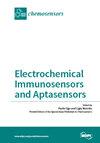基于石墨烯氧化物的全固态电位传感器作为离子-电子转换器用于水样中硝酸盐的检测
IF 3.7
3区 工程技术
Q2 CHEMISTRY, ANALYTICAL
引用次数: 0
摘要
在以烷基铵盐为传感元件的全固态硝酸盐电极中,氧化石墨烯(GO)被用作离子到电子的换能器。使用市售的经 GO 修饰的碳丝网印刷电极作为导电基底,并通过扫描电子显微镜和拉曼光谱对其形态和沿表面的分布进行了评估。基于 GO 的电极的电位性能显示,在 3.0 × 10-6 至 10-2 M 的范围内,其 Nernstian 斜率为 -53.5 ± 2.0 mV decade-1(R2 = 0.9976 ± 0.0015),检测下限为 1.9 × 10-6 M。这些研究结果表明,在制造全固态电位电极时,可以使用 GO 作为离子到电子的替代换能器。本文章由计算机程序翻译,如有差异,请以英文原文为准。
All-Solid-State Potentiometric Sensor Based on Graphene Oxide as Ion-to-Electron Transducer for Nitrate Detection in Water Samples
Graphene oxide (GO) was used as an ion-to-electron transducer for all-solid-state nitrate electrodes based on an alkyl ammonium salt as the sensing element. Commercially available carbon screen-printed electrodes modified with GO were used as conductive substrates, whose morphology and distribution along the surface were evaluated by scanning electron microscopy and Raman spectroscopy. The potentiometric performance of the GO-based electrodes revealed a Nernstian slope of −53.5 ± 2.0 mV decade−1 (R2 = 0.9976 ± 0.0015) in the range from 3.0 × 10−6 to 10−2 M and a lower limit of detection of 1.9 × 10−6 M. An impressive reproducibility between equally prepared electrodes (n = 15) was demonstrated by a variation of <6% for the calibration parameters. Constant current chronopotentiometry and water layer tests were used to evaluate the potential signal stability, providing similar performance to previously published works with graphene-based ion-selective electrodes. Notably, the GO-based sensors showed the absence of a water layer, a long-term drift of 0.3 mV h−1, and a stable performance (LOD and sensitivity) over 3 months. The applicability of the proposed sensors was demonstrated in determining nitrate levels in water samples with great accuracy, yielding recovery values from 87.8 to 107.9%, and comparable (p > 0.05) results to a commercial nitrate probe. These findings demonstrate the use of GO as an alternative ion-to-electron transducer for the fabrication of all-solid-state potentiometric electrodes.
求助全文
通过发布文献求助,成功后即可免费获取论文全文。
去求助
来源期刊

Chemosensors
Chemistry-Analytical Chemistry
CiteScore
5.00
自引率
9.50%
发文量
450
审稿时长
11 weeks
期刊介绍:
Chemosensors (ISSN 2227-9040; CODEN: CHEMO9) is an international, scientific, open access journal on the science and technology of chemical sensors published quarterly online by MDPI.
 求助内容:
求助内容: 应助结果提醒方式:
应助结果提醒方式:


